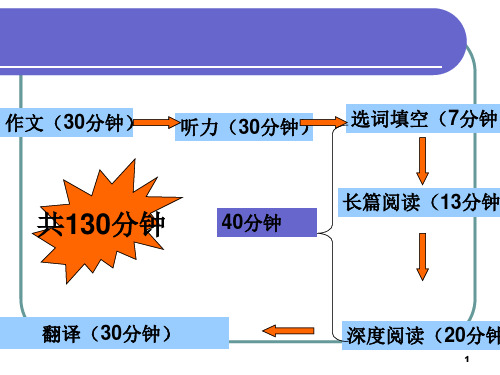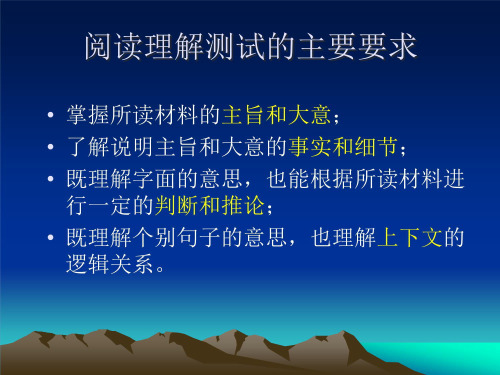大学英语阅读理解解题技巧(课堂PPT)
大学英语四级阅读技巧ppt课件

[D] As for children’s books, who knows? Children’s books are like dog food in that the purchasers are not the consumers, so the market (and the marketing) is inherently strange.
23
[C] Physical books will surely become much rarer in the marketplace. Mass market paperbacks, (which have been declining for years anyway, will probably disappear,) as will hardbacks for mysteries, thrillers, “romance fiction,” etc. Such books, which only rarely end up in permanent collections, either private or public, will probably only be available as e-books within a few years. Hardback and trade paperbacks for “serious” nonfiction and fiction will surely last longer. Perhaps it will become the mark of an author to reckon with that he or she is still published in hard copy.
大学英语四级阅读理解技巧及方法64页PPT

46、我们若已接受最坏的,就再没有什么损失。——卡耐基 47、书到用时方恨少、事非经过不知难。——陆游 48、书籍把我们引入最美好的社会,使我们认识各个时代的伟大智者。——史美尔斯 49、熟读唐诗三百首,不会作诗也会吟。——孙洙 50、谁和我一样用功,谁就会和我一样成功。——莫扎特
大学英语四级阅读理解技巧及方法
•
6、黄金时代是在我们的前面,而不在 我们的 后面。
•
7、心急吃不了热汤圆。
•
8、你可以很有个性,但某些时候请收 敛。
•
9、只为成功找方法,不为失败找借口 (蹩脚 的工人 总是说 工具不 好)。
•
10、只要下定决心克服恐惧,便几乎 能克服 任何恐 惧。因 为,请 记住, 除了在 脑海中 ,恐惧 无处藏 身。-- 戴尔. 卡耐基 。
英语四级阅读解题技巧(三种题型)PPT课件

1.1 文章分类
1) 带小标题的文章: 文章每一部分,都有一个总括性 的小标题,小标题一般概括这一部分的主题;
2) 不带小标题的文章: 没有明显的每一部分的分隔, 需通过略读找出主题句或主题词(特别关注首段或 段尾).
2021
8
2. 命题规律
Rule 1: 问题设置顺序与行文顺序基本一致。 Rule 2: 问题通常为文章的主要内容及与主要
空格处前面是名词/代词,后面没有宾语,空格处应填不及物 动词;
空格处前面是名词/代词,空格处后面是副词/介词,空格处 应填入不及物动词,与副词/介词构成固定搭配
For example, women now _purchase_ about half of all cars.
2021
32
注意:
1.确定的选项,划掉。 2.读不懂的句子和做不出的题,不要停下来 继续读下去,或许可从后面的内容中得到启发, 然后联系上下文在剩下的选项中选择答案。 3.符合条件的单词有两个甚至更多时,结合上下文语境或固定搭配 对该空所需单词意思及词性进行二次判断。 4.再次复读全文,自我感觉上下文是否通顺、内在逻辑是否连贯。
2、具体操作: (以2012年真题为例)
►(1)先看标出文章段落
► (目的是推测答案所在段落,段落数超过题目数,说明有 些段落可跳读或略读)
►(2)读文章首尾句
► (目的是了解文章内容的主方向)
►(3)先依次仔细阅读题目,挑出关键词
(可能有一个,也可能是两个,三个)
► (目的是了解文章讨论的事情发展方向)
2021
13
4、快速阅读选择题的做法
►(1)快速标出文章段落数
► (若段落数目远远超过题目数目,则说明有些段落可跳读, 若段落数少于题目数,说明有的段落含有两个问题的答案, 若段落数刚好10段,则一般是一段一个问题所在)
英语阅读理解技巧ppt课件

掌握了找主题句的方法,就可以依据主题 句归纳主题。但归纳主题容易出现以下三 种错误,需要同学们注意。
说明文多见于科普文章,用以解释或揭示事物的状态、特
征、演变、结果及其相互之间的关系,这类文体的文章,
首句往往是主题句,开门见山,说明文章的关注对象:弄
清作者的思路和段落组织的方式;把握次要信息及其与主
题的关系。
体裁分析能力
论述文的阅读难在这种文章处处都渗透作者的个人观点、 态度。阅读论述文应该从文体的写作和结构特点入手. 文章的结构往往容易把握,用主题句开门见山。作者往往 通过信号词(signal words或transitional words)和关联词 (referents来组织段落、文章.对信号词的迅速反应和对关 联词的准确判断是至关重要的;要特别注意区分作者的观 点与文章里所提到的人物的观点,同时注意作者所使用的 表示赞同、反对等感情色彩的词汇。
高三英语专题复习
英语阅读理解技巧
教学内容
体裁分析能力训练 分析题干能力训练
猜词能力训练 猜答案能力训练
摒弃不良的阅读习惯。
1.“指读” 2.“声读” 3.“译读” 4.“回读” 5.“析读” 6.“参照读” 7.“视幅过窄” 8.“毛病”(bad habits): 教学过程中,发现学生在 阅读时常做些不利于阅读的坏动作。有的同学晃头、颠腿 、转笔、听音乐、咬指头、趴在桌子上、揪头发等等。
大学英语四级阅读方法技巧讲解PPT

Thank you!
• 解析:文章段落内容冗长,但只需抓住重点即 可快速做答。题目问到两个公司 Reebok和Nike ,快速浏览段落就可以发现这两个公司是在最 后一句才同时出现的。所以先忽略过前面的内 容,重点看最后一句。题目问的是Reebok 从 Nike的分销问题上能汲取什么教训,而最后一 句明显提到Nike在几年前错误判断了一个事情, 此时考生不用往下再看,紧紧抓住misjudge这 个动 作:既然Nike在几年前misjudge,Reebok 汲取到的教训当然是不要misjudge,直接对应 D选项中的correctly evaluate,即“正确评估”。
• 第二步,对照答案,针对做错的题目,在不查单词的前提 下,尽量根据上下文看出答题线索,并总结错误原因。
•
考生要抓住长难句的逻辑结构和论述方向来理解段落,
应对题目。段落的开头和结尾也属于比较重要的位置,重
点把握这两个位置,就能迅速了解段落大 意。同时,考生
千万不要小看文章中出现解释或说明的地方,那往往是考
• 下面举个例子:
• 例:Reebok has already anticipated that walking shoes will be the next fitness_related craze replacing aerobics shoes the same way its brightly colored, soft leather exercise footwear replaced conventional running shoes. Through product diversification and careful market research, Reebok hopes to avoid the distribution problems Nike came across several years ago, when Nike misjudged the strength of the aerobics shoe craze and was forced to unload huge inventories of running shoes through discount stores.
英语阅读理解阅读技巧最新PPT课件

? 2、原文的作用
? 接受原文时,只接受字面意思,文章的原文 不能告诉我们哪个答案是对的,但是 能告诉我 们那些答案肯定是不对的 。若直接从原文得答 案,必须走充分这条路, 即要符合原文,又要 符合题意。用不充分性思维做题,大家都明白, 凡是正确答案,必定和原文有所关联,当题目 看不懂、文章看不太懂时,选出有可能和原文 沾边的选项,排除不沾边的选项。
? a student killed 20students ; ? the news lead to great concern 。
阅读顺序---先读文章还是先读题
?大多数考生在考试中,采用的是读文章、做 题目、如果拿不准的再回头读文章。有时候 可能还有循环重复下去,这种方法有点是准 确率较高,缺点是阅读速度慢,效率低。也 有一些考生先浏览试题,记住大致的考点, 再读文章,划下重点部分,最后做题。也有 考生直接从问题入手,边读题边到文章中去 寻找答案。还有一种就是不读文章只做题目, 这属于“狗急跳墙型”。
三.积极的阅读态度: 较高境界的阅读是把注意力集中到作者的 思想和整体脉络上面,而不是个别的零碎 的单词上面。
?
高考文章的脉络
? 时间顺序:按照时间的先后顺序说明某一理论、
某一现象的发展或某一研究成果由过去到现在
的情况。
? 一般到具体:首段做总的说明,其他段落分别 说明或论述首段观点。
? 具体到一般:前面几段分别说明,末段总结。
? 对比说明:以进行对比的两个事物之间的基本 共同点或差异点为主题进行展开。
顺承式和转折式文章
? 顺承式结构指的是前后两个部分之间内容相近, 相辅相成,通常由下列连接词连接:similarly; first; second; because; thus等。
大学英语六级技巧阅读篇PPT课件

结束语
感谢聆听
不足之处请大家批评指hortcomings
讲师:XXXXXX XX年XX月XX日
选词填空·解题步骤
1、整理选项 这一步,公认的做法是先标出15个选项的词性(parts of speech)
注:标注词性时注意的问题: 1. 不认识的单词看词缀 2. 认识的单词要注意词性的单一性和多样性, 都要标出 来,
先标脑子里第一个出现的词性。 3. 动词归类要细分为v,v-ed, v-ing。 4. 以-ing, -ed 结尾的词也可能是分词转变而来的形容词,
信息匹配·做题原则
3) 非顺序原则
信息匹配·做题原则
4) 匹配原则 十个句子与原文定位处需有明确的匹配关系:以 同义改写,正话反说,反话正说等方式对应原文 的内容
仔细阅读·要求
• ①掌握所读材料主旨和大意的方法和能力 • ②辨别说明主旨和大意的事实和细节的方法和能力 • ③既能理解字面的含义,也能根据所读材料进行一定的判断
No pains, no gains
• 大学英语六级备考· 阅读篇 College English Test Band-6
六级阅读·要求
阅读总时间 40min
分数比例
35%
题型分配
选词 信息匹配 仔细阅读
选词填空·要求
选词部分要求考生从十五个单词中选出十个,填 在一篇250字的短文的十个空格中,使短文意思完 整。考生必须在5分钟之内把这道选词填空题做完。 做选词填空,关键是在保证正确率的前提下提高 速度。
3、选词填空 调动语法知识,先根据句子结构确定词性,
然后根据自己先前的词性判断,挑出正确答案。
选词填空·解题步骤
4、回顾检查 将答案带入全文,再次通读,看所选的答案是否能
大学英语四级阅读理解解题技巧ppt课件

4.infer 类:不是细节就是主题。
完整最新ppt
19
推理题必须注意:
1. 同义替换是关键(过于绝对,扩大缩小范 围,推理过头都是错误的)
2. 就近原则(勿跨段推理)
3.忠于原文,切忌用自己的观点取代作者原 意。
完整最新ppt
20
是非型
是非也是细节题。 与主旨题一起留到较后。要读完整篇文章
完整最新ppt
12
按照“意群”来阅读。
“意群”,就是“意思的群体”,它可以向 读者传达一组信息。比如,介词短语、不 定式、长主语等都可以视为一个意群。因 此,我们在阅读理解的过程中,一旦遇到 上述地方(介词短语、不定式、长主语 等),需要停顿一下。有效的断开句子, 分清意群,不仅可以提高阅读速度,更便 于读者对文章的理解。
c. 通过句子中的代词(如it ,they ,those ,this ,he ,she等) 的指代关系及句子的时态等,将该句子内容与上 下句联系起来,对理解句子会有很大的帮助。
d. 如果句子很长,就要对句子进行结构分析。先 去掉介词短语、定语从句,搞清主谓,然后再把 这些东西加回去。
完整最新ppt
项,文章中作者根本没有提到。 二是答案本身错。所谓答案本身措就是给出的选
项本身就是错误的。 三是张冠李戴。所谓张冠李戴是最能干扰考生的。
就是明明是说A的偏偏要说B。考生由于读文章不 仔细,乍一看选项是自己所熟悉的,并且是文章 中出现过的。于是便毫不犹豫地选了它,殊不知 是错误的。
完整最新ppt
24
辑关系; 根据所读材料进行一定的判断和推理; 领会作者的观点和态度。
完整最新ppt
4
阅读理解题型
1.对主题句的考查 2.细节题(对一些事情的细节的考查) 3.推断(推理)题 4.对作者的态度的考查 5.词义题目(对生词的记忆的考查)
大学英语四级阅读理解技巧PPT课件

火灾袭来时要迅速疏散逃生,不可蜂 拥而出 或留恋 财物, 要当机 立断, 披上浸 湿的衣 服或裹 上湿毛 毯、湿 被褥勇 敢地冲 出去
• 要带着问题阅读,这样可以节省时间。 • 从问题中找关键词(人名、地名等大写的
醒目的)然后在原文中找到相应部分 • 再来就是要多阅读文章,做到即使不是很
火灾袭来时要迅速疏散逃生,不可蜂 拥而出 或留恋 财物, 要当机 立断, 披上浸 湿的衣 服或裹 上湿毛 毯、湿 被褥勇 敢地冲 出去
是非题
• 是非题主要考查考生对某个特定细节的判断辨知能力。要求考生能根 据文章的内容,对所提问题真实与否,在文章中是否提及等做出正确 的判断。
• 此类题常见的提问方式有: Which of the following statements is TRUE/NOT TRUE? All the following are true except 。 Which of the following is NOT mentioned (included, implied) in the passage? All of the following statements have relevance to....except…
4. 如果要是推断文章中没出现的前一段或下一段的内容,应 在仔细阅读并理解了文章内容的基础上,重点分析文章的 首、尾两段尤其是文章的开始句和结束句。
5. 针对文章人物性格的推断在考试中不太常见,但是对于人 物性格的分析有助于理解作者的观点,因此,在阅读中要 注意对人物的语言、动作、行为等的描述。
火灾袭来时要迅速疏散逃生,不可蜂 拥而出 或留恋 财物, 要当机 立断, 披上浸 湿的衣 服或裹 上湿毛 毯、湿 被褥勇 敢地冲 出去
火灾袭来时要迅速疏散逃生,不可蜂 拥而出 或留恋 财物, 要当机 立断, 披上浸 湿的衣 服或裹 上湿毛 毯、湿 被褥勇 敢地冲 出去
2024英语四级阅读解题技巧PPT课件

课件•Overview of question types andproblem solving strategies•Tips for solving detail comprehensionproblems目•The method of solving the main ideaproblem录•Strategies for solving reasoning andjudgment problems•How to deal with vocal comprehensionquestions目•Sentence fill in the blank questionanswering skills录01Overview ofquestion typesand problemsolvingstrategiesThese are the most common type of questions in CET-4 reading comprehension, requiring students toselect the best answerfrom multiple options MultipleChoiceQuestionsStudents must determine which statement is true orfalse based on the information provided inthe passage True or False Questions These questions test students' understanding of specific details or concepts by asking them to complete a sentence or paragraph with the correct information Fill in the blank Questions Students must match items from two different lists, such as matching heads with paragraphs or matching definitions with termsMatching Questions Introduction to CET-4 Reading Question TypesGeneral problem solving strategies•Skimming and Scanning: Skimming investments quickly reading the passage to get a general understanding of the main idea, while scanning investments searching for specific information or keywords•Understanding Question Types: Familiarizing yourself with the different types of questions and understanding what each type is asking for can help you approach the passage more effectively •Identifying Key Information: Learning to identify key information in the passage, such as the main idea, supporting details, and the author's purpose or title, is critical for answering questions correctly •Eliminating Incorrect Answers: Narrowing down your options by eliminating answers that are clearly incorrect can help you focus on the most likely correct answersTime management and answering sequence•Allocation Time: It is important to allocate your time willingly when taking the CET-4 reading comprehension section Determine how much time you have for each pass and question, and stick to your plan•Reading the Questions First: Sometimes it can be helpful to read the questions before reading the passage, as this can give you a better idea of what information you should be looking for •Answering Easy Questions First: If you come across a question that seems particularly difficult, it may be best to skip it and come back to it later Answering the eastern questions first can help you build confidence and momentum•Reviewing Your Answers: After you have finished answering all the questions, take a moment to review your answers and make sure that you have not missed any objective misses02Tips forsolving detailcomprehension problemsIdentify key information and vocabularyPay attention to nouns, ve…These word classes often contain important information and help tounderstand the main idea of the textLook for key phrases and presence structuresKey phrases and presence structures can provide clubs to the meaning of thetext and help to locate important information quicklyBe aware of synonyms and antonymsUnderstanding synonyms and antonyms can help to understand the meaningof words in context and avoid misunderstandingsPositioning the original text and answer areaRead the question carefull…Before looking for the answer in the text, it is important to understand whatinformation is being asked forScan the text quickly to locate relevant informationOnce the key information in the question has been identified, scan the textquickly to find the relevant sectionRead the relevant section carefully to find the answerAfter locating the relevant section of the text, read it carefully to find theanswer to the questionTechniques for identifying interference itemsEliminate objectively incorrect optionsSometimes there will be objectively incorrect options that can be identifiedimmediatelyCompare and contrast similar optionsIf there are multiple similar options, compare and contrast them to find the onethat best fits the information in the textUse determination method to arrow down choicesIf there are still several possible answers after identifying objectively incorrectoptions, use the determination method to arrow down the choices furtherExample analysis and practiceAnalyze example questions and answersLooking at example questions and answers can help understand how to apply the tips andtechniques learned in this sectionPractice with real CET-4 questionsPracticing with real CET-4 questions is essential for training confidence and improving problemsolving skillsReview and reflect on performanceAfter practicing, review your answers and reflect on your performance to identify areas forimprovement03The method ofsolving themain ideaproblemRead the title and subtitle to get a general idea of the content Skim through the articlequickly to grasp the mainpoints and structureIdentify the topic presenceof each paragraph tounderstand the main idea ofeach sectionDetermine the central idea of the articlePay attention to keywords that are repeated or emphasized in the textAnalyze the logical relationship between paragraphs to understand the connection betweenideasLook for topic senses at thebeginning or end of eachparagraphIdentify paragraph topic senses and keywordsSummarize the main idea of the article in your own words Identify the author's purposeand attitude towards thetopicAnalyze the languagefeatures and rhetoricaldevices used by the author toconvey the messageSummarize the main idea and techniques of the entire textExample analysis and practiceAnalyze sample questions and answers to understand the question typesand answering techniquesPractice solving main idea problems with different articles and questiontypesReflect on your own answers and compare them with the correct answers toidentify areas for improvement04Strategies forsolvingreasoning andjudgmentproblemsUnderstand the author's viewpoint and titleIdentify key senses and words01Look for topic senses, including senses, and words withemotional color to understand the author's viewpoint and titleAnalyze the author's argument02Examine the evidence and reasoning the author uses to supporttheir viewpoints, and identify any assumptions or biasesAdvisor the author's background03Take into account the author's expertise, experience, and anypotential conflicts of interest that may affect their viewpointInferring implied information or conclusionsRead between the linesLook for hints or clubs in the text that suggests whatthe author may be implying but not directly statingUse logical reasoningApply logical reasoning skills to draw conclusionsbased on the information provided in the textAdvisor the overall contextTake into account the larger context of the text,including the author's purpose and intendedaudience, to infer implied information or conclusionsIdentify facts andopinionsDistinguish between facts and opinions in the text, and determine which are relevant to the question at hand Evaluate evidenceand reasoningAssess the quality andeffectiveness of the evidenceand reasoning provided tosupport a specific viewpointor conclusionProvide reasonsand explanationsClearly explain why a specificanswer is correct or incorrect,and provide evidence andreasoning to support youranswerDetermine right and wrong and provide reasonsAnalyze samplequestionsExamine sample questions and answers to understand the types of reasoning and judgment problems you may account for on the CET-4 exam Identify commonmissesLook for common misses madeby students when solving thesetypes of problems, and learn howto avoid themPractice solvingproblemsPractice solving reasoning andjudgment problems using thestrategies you have learned, andseek feedback on your answers toimprove your skills010203 Example analysis and practice05How to dealwith vocalcomprehension questionsTechniques for guiding the meanings of unfriendly wordsWord formationUnderstanding word roots,prefixes, and suffixes can helpguide the meanings of unknownwordsWord associationAssociating unfriendly words withknown words or concepts can aidin comprehensionUsing examples Looking for examples orillustrations that account forunfamily words can clarify theirmeaningsUsing contextual clues to infer word meaningsReading the presence or pa…Understanding the context can provide includes to the word's meaningPaying attention to grammar and syntaxThe structure of the presence or paragraph can give hints about the meaningof unfriendly wordsConsidering the overall theme or topicUnderstanding the browser theme or topic of the text can help infer themeanings of specific words1 2 3Looking for words or phrases that have similar meanings to the unfriendly word can be aid in comprehensionSearching for synonymsA Thesaurus is a useful tool for finding synonyms and antonyms of unknown words Using a ThesaurusTrying to rephrase the presence containing the unfriendly word can help identify a suitable synonymRephrasing the presenceIdentify synonyms or synonym replacements01 02 03Analyzing sample questionsLooking at sample vocabulary comprehension questions and answers can help understand the types of questions that may be askedPracticing with real CET-4 materialsUsing authentic CET-4 reading materials for practice can help familiarize yourself with the vocabulary and question typesTimed practice sessionsSetting timed practice sessions can help improve speed and accuracy when dealing with vocal comprehension questions during the actual examExample analysis and practice06Sentence fill inthe blankquestionansweringskillsAnalyze sensitivity structure and determine the type of fill in the blankIdentify the subject, predict, andobject of the presence tounderstand its basic structureDetermine the type of fill in theblank, such as noun, verb,advisory, or advisory, based onthe presence structure andcontext Pay attention to any hints or clubs provided by the presence, such as positions, connections, or junction marksChois单击此处添加正文,文字是您思想的提炼,为了最终呈现发布的良好效果,请尽量言简意赅的阐述观点;根据需要可酌情增减文字,以便观者可以准确理解您所传达的信息,请尽量言简意赅的阐述观点;根据需要可酌情增减文字,以便观者可以准确理解您所传达的信息。
四级详细阅读技巧Ppt讲课文档

joined by a new face; Andrew Hamilton, the 55-year-old
provost (教务长) of Yale, who’ll become Oxford’s vice-
chancellor—a position equivalent to university president
第七页,共23页。
• Of course, fund-raising isn’t the only skill outsiders offer. The globalization of education means more universities will be seeking heads with international experience of some kind of promote international programs and attract a global student body. Foreigners can offer a fresh perspective on established practices.
第十二页,共23页。
• 66. In what way do top-level administrators from abroad contribute to university development?
•
A) They can enhance the university’s image.
globalization.
•
D) Most of their revenues come from the
government.
第十一页,共23页。
• 65. Cambridge University appointed Alison Richard as its vice-chancellor chiefly because _____.
大学英语四级———快速阅读做题技巧PPT课件

你知道吗???
❖ 一 在平时做英语阅读训练的时候,要定好了时 间训练,多练习就会适应快速阅读了,而且还能 找到做题的技巧。
❖ 实现它应有的效果。
4
一、快速阅读的命题规律
❖1. 逻辑关系处常设考点 ❖ 逻辑关系散布在文章的句子中、句句之间以及段
13
注意:
❖一、把没用的信息跳过。想找到有用的信息,
先要知道你要什么信息,才能有的放矢。要记住 尽量少但最有效的问题单词或者句子。要找这样 的单词:原文当中出现而且题目也出现,这样的 单词是重点,文章出现这样单词的前后要着重的 读,很可能大家就在这。
❖ 二、如果你找不到这样的单词,就要看懂问题问 的是什么,然后带着这个问题在读文章的时候要 有目的的读,遇到了就要仔细的读,很可能问题 大家就在那附近。
10
2024/10/14
11
❖ 定位词的本质:特殊性和细节性。 ❖ 文章中多次出现的语汇不是定位词。越细节越特
殊的词,在文章中出现的频率越低,一旦找到, 它旁边的信息应该就是考点了。
12
❖ 意题干中的定语和状语。 ❖ 定语可以使一个概括性的概念更加细节化,状语
可以使一个一般性的动作更加特殊化。所以,如 果题干较长,又没有特殊印刷体文字的情况下, 选取定语和状语中有代表性的词作为定位词,比 较可靠。当然不排除主语和谓语本身就很特殊, 或者考点词本身就是定位词的情况。
2
❖ 因为scanning的过程只是在查找,所以,在这 个时候,所有词汇都蜕变为符号。
❖ 定位词是个符号,原文所有词都是符号。 scanning是个符号对应的过程。眼睛如探照灯, 同时扫过好几行——找符号。
❖ 纠正scanning的错误,就是纠正在查读过程中, 总是想词汇意思的习惯。
大学英语四级阅读理解解题技巧PPT课件

4. 态度题的解决方法: 态度题(Attitude,Tone)可以考查作者对一
个中心话题的看法,也可以考查作者对某一 具体细节的态度
14
常见观点
positive 积极的 neutral 中立的 disapproval 不赞成的
的
sarcastic 讽刺的 optimistic 乐观的
negative 消极的 approval 赞成的 indifferent 漠不关心
17
标注文章的重点。 英语文章的重点主要有以 下几点:
1.强转折:通常由“but, yet, however”引导。 特别是在文章中出现but。
18
2.比较处:通常形式为“more/less---than---”。 3.主旨句、主题句,直接反映出作者的写作
目的和意图,因此也是出题人的出题点。 另外还有因果句、独立成段句、长难句乃至
6
阅读多为说明文、议论文,有时也会出现 记叙文,但讨论的多数是社会问题:
关注热点问题 环保问题 新科技的发展——网络、电子、物理学等 社会类问题——性别歧视、子女教育、文
化差异、失业率、家庭犯罪等。
7
经济问题 体育——与社会发展相关 个人发展史——夹叙夹议,与文学、历史相
关。
8
阅读理解题型
阅读理解
1
阅读15选10
2
解题步骤:
阅读选项,词性分类。动词归类要细分为v, ved, ving。
细读首句,抓住中心。 全盘考虑,灵活选择。 复读全文,核查答案。
3
判断原文空缺处所需单词的词性
1. 一个句子有且只有一个谓语动词。 2. 名词主要做主语、宾语。 3. 形容词或名词都可以修饰名词。
critical 批评的 pessimistic 悲观的
大学四级阅读理解技巧PPT课件

2024/1/29
14
推理判断题的解题策略
01
仔细阅读题干和选项,理解问 题的核心要求。
02
根据文章内容进行推理和判断 ,注意逻辑关系和上下文联系 。
03
排除干扰项,选择最符合文章 内容的答案。
2024/1/29
15
识别作者观点和态度
注意文章中的情感词汇和语气,理解作 者的情感倾向。
2024/1/29
31
THANKS
感谢观看
2024/1/29
32
8
识别同义词和反义词
2024/1/29
识别同义词
同义词是指意思相近或相同的词语。 在阅读中,可以通过识别同义词来理 解文章的意思,同时扩大词汇量。
识别反义词
反义词是指意思相反或相对的词语。 通过识别反义词,可以更深入地理解 文章的意思,同时增强对词汇的掌握 。
9
利用上下文推测词义
联系上下文理解词义
识别关键连接词
关注表示转折、因果、递进等关 系的连接词,如“然而”、“因 此”、“此外”等。
2024/1/29
18
寻找主题句和关键信息
寻找主题句
主题句通常位于段落首尾,概括该段落的主要内容。
提取关键信息
关注与主题相关的重要细节,如数据、例子、专家观 点等。
忽略次要信息
略读不重要的细节,如具体的时间、地点等,以提高 阅读速度。
5
阅读理解能力要求
01
02
03
04
05
理解主旨要义
理解文中具体信 息
根据上下文推测 词义
进行判断和推理
理解作者的意图 、观点和…
能够概括文章的中心思想 和主题。
能够准确获取文章中的具 体事实和细节。
大学英语四级阅读理解技巧仔细阅读篇精品PPT课件

1.主旨题
考查点:短文主题或中心思想 出题形式:多变. 一般包括main idea; main topic; purpose
or best title等。如: 1) The main (central) idea of this passage is ______. 2) The passage is mainly about ______. 3) The main purpose of this passage is ______. 4) The best title for this passage is ______. 5) What conclusion can be drawn from the passage? 6) The subject or topic of the passage is ______. 7) The best title of the passage is ______.
逻辑关系的理解。(偶尔) 出题形式:直观。如:The pronoun “it”
(para. 3, line 2)refers to ______. 解题技巧:返回原文往前找就近的核心名
词
2. 细节题
细节题干扰项5字特点: 反:相反 无:不存在 混:张冠李戴 偏:片面性 变:改变原文中的词义/指代功能。
3. 结构题
考查点:文章结构的理解 出题形式:三种 1) 例证型 提问方式:
The author provides in Line…(Paragraph…)an example in order to … How does the author illustrate the idea of … ? The author develops his main idea by ______.
大学英语四级阅读技巧PPT课件

1.长篇阅读的文章基本都是专业题材的文章,
很多考生可能会觉得很陌生,不要求完全理解 只要求能够通过略读或查读的方式找到题干的 信息并根据原文内容相比做出正确选择。只是 有题干和答案简单的同义词替换 。 2.略读(Skimming)和寻读(Scanning)的能力在 大学英语四级考试中显得尤为重要 3.快速阅读要求考生的阅读速度是每分钟110140词
2021
3. 确定空格为形容词: 修饰名词或表示状态 (1)空格后面为名词,空格处应填入形容词; ___ + N.(
充当宾语或主语) (2)空格前面是副词,空格处应填入形容词;
adv+____ (充当表语或定语)
(3)空格前面是系动词,空格处应填入形容词作表语.
Be ,become, fall ill, keep silent, look/seem tired, grow
及格
在答题纸1上作答, 完成后交答题纸1. 剩下题目在答卡2上 作答.
426
35%
翻译15%
选词填空5% 长篇阅读10% 深度阅读20%
2021
阅读理解分值
新四级考试的阅读部分主要分为选词填空,长篇阅读和 深度(仔细)阅读三个部分。阅读分数占全卷的35%.
阅读理解(40mins)
35%
选词填空7 长篇阅读13仔细阅读20
2021
Pejorative prefixes: Mal—(badly), malnutrition,maltreat Mis—(wrongly), mislead, misunderstand Pseudo—(false, imitating), pseudonym,
2021
Prefixes of degree or size: Co—(joint): coexistence, cooperation, Hyper –(extreme): hypertention, Mini: minibike, Out—(surpassing): outnumber Over-, sub-, super-, overpass, subtitle Bi- , tri- bicycle, tricycle
大学四级阅读理解解题技巧ppt课件(2024)

隐含意义挖掘及作者态度把握
隐含意义挖掘法
通过深入分析文章中的措辞、语气等,挖掘出作者的隐含意图。
2024/1/28
作者态度把握法
识别文章中的情感词汇和评价性语言,理解作者对所述内容的态度 。
文化背景分析法
考虑文章所涉及的文化背景和社会环境,更好地理解作者的立场和 观点。
18
05
主旨大意与标题选择
长句简化法
将文章中的长句简化为短句,便于快速理解 和定位关键信息。
16
上下文联系及推理判断能力训练
2024/1/28
上下文联系法
通过阅读前后文,理解文章的整体逻辑和内在联系 。
推理判断法
根据已知信息,推断出文章未明确表述的内容或含 义。
例证分析法
通过分析文章中的具体例子,理解作者的观点和态 度。
17
不注重词汇和语法的积累 。
应对策略
学会略读和扫读技巧,快 速浏览文章,抓住关键信
息。
2024/1/28
应对策略
注重文章结构和段落主题 句的理解,把握文章中心
思想。
应对策略
平时注重词汇和语法的积 累,提高阅读速度和准确
性。
5
备考建议与注意事项
制定备考计划
根据自身情况制定合理的备考计划,明确每天的学习任务和时间安排 。
分析句子结构
识别句子中的从句、非谓语动词等复杂结构,理清句 子层次。
理解上下文
结合文章背景和上下文语境,推断长难句的具体含义 。
2024/1/28
9
语法知识在阅读中的应用
01
理解句子成分
运用语法知识分析句子成分,如 定语、状语等,有助于更准确地 理解句意。
02
- 1、下载文档前请自行甄别文档内容的完整性,平台不提供额外的编辑、内容补充、找答案等附加服务。
- 2、"仅部分预览"的文档,不可在线预览部分如存在完整性等问题,可反馈申请退款(可完整预览的文档不适用该条件!)。
- 3、如文档侵犯您的权益,请联系客服反馈,我们会尽快为您处理(人工客服工作时间:9:00-18:30)。
3
LOGO
❖ The French Revolution broke out in 1789. At the time France was in a crisis. The government was badly run and people’s lives were miserable. King Louis XIV tried to control the national parliament and raise more taxes. But his effort failed. He ordered his troops to Versailles. The people thought that Louis intended to put down the Revolution by force. On July 14, 1789, they stormed and took the Bastille, where political prisoners were kept.
C. there was a car accident.
D. they were too tired to do it themselves.
2. On their way home the couple __________.
A. found a murder.
B. found a robbery. C. first noticed smoke and then they found a house in fire.
12. Which did not happen in 1789?
B
A. The French Revolution broke out.
B. The national economy was developing rapidly.
C. The government wasn’t well run.
❖ 查读(Scanning):这种阅读方式适于寻找具体细节,例如: 事实、数字、人物、原因、年代、方式等。这种方法主要 用于做细节题。
❖ 细读(Reading for full understanding):这种阅读方式适
于某些需要判断或思考的问题。对于这种问题先要找到它
在文章中的相关段落,然后逐句阅读,特别是对与问题有
D. King Louis XIV was in power.
13. Where were the political prisoners kept?
A. In Versailles. C. In Prussia.
B. In Austria. D. In Bastille.
D
4
LOGO
A couple, John and Mary, had two lovely children. John had just been asked to go on a business trip and would be gone for several days. Mary would go along too. They hired a reliable woman to care for the children and made the trip, returning home a little earlier than they had planned. As they drove into their hometown, they noticed smoke, and they went off their usual route to see what it was. They found a home in flames. Mary said, "Well, it isn't our fire, let's go home.“
阅读理解应试技巧
LOGO
1
❖ 一、阅读方法:
首先,在解题前,应先快速浏览文章后的问题,找出题干
中的关键词,明确需要解决的问题,这样阅读的目的就很 明确;然后带着这些问题的关键词句开始阅读,并结合以 下三种阅读方法解不同的题型。
❖ 略读(Skimming):这种阅读方式用于快速浏览,其主要 目的就是把握全文的大意。要按意群扫视,连贯阅读;要 特别注意文章的开始段、结束段、每段的首句和结尾句以 及段落之间的连接词语和文章中的信息词,它们往往是了 解文章大意的关键。
关的关键词、关键句要仔细2 推敲。
LOGO
❖ 二.阅读考题类型及相应的应答技巧
❖ (一)细节题: ❖ 主要是考查学生对文章某些事实的细节和数据的掌握,这
类问题的答案一般都能在原文中找到。对于事实细节题, 关键是要定位准确。应首先找到它的考查点,这种题只要 找到细节题所在的地方,再联系上下文,然后根据它的命 题规律答题即可。这类题的题干+答案在意义上通常等于 原文中某一部分的内容,也就是说用不同的表达方式使题 干+答案与原文等值(即同义结构,如:educational institution school; make strenuous efforts strive)。文 中的时间、地点、人物、数量或事实多为提问的对象(即 when, where, who, why, how, how many/much,..),而这 些问题的表达常不采用文章中的原话提问,而是使用同义 词语等,因此,在选择答案前应首先看准题干,看清问题 所问究竟是什么细节内容;然后,在查读时注意寻找与题 目相关的关键词语;最后,在充分理解原文、原题的基础 上确定答案。
C
D. found that they were running out of gas.
1. .John and Mary hired a woman to look after their children when ________.
A. the children were getting out of control.
B
B. John would be on a business trip and Mary would go along, too.
